India on Saturday, January 26, celebrated the 70th Republic Day with a grand military parade and exhibition of its history, cultural diversity and strategic weaponry at the Rajpath -- New Delhi's centrepiece boulevard -- in the presence of thousands of spectators including foreign dignitaries and the country's top political and military brass.
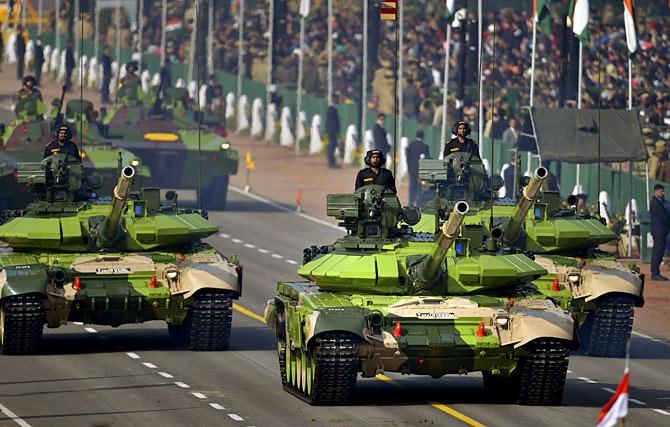
A total of 22 tableaux -- 16 from states and Union territories and 6 from central government ministries and departments -- were part of the cultural parade, the overall theme of which was the 'life and ideals' of Mahatma Gandhi.

South African President Cyril Ramaphosa was the chief guest at the 90 minute celebrations marking the anniversary of the day when the world's biggest democracy was declared a republic in January 1950.
Ramphosa's presence at the event was significant as India is celebrating the 150th birth anniversary of the father of the nation who had spent 21 years in South Africa before returning to India to join the freedom struggle in 1915.

The parade began after President Ram Nath Kovind conferred the Ashoka Chakra -- India's highest peacetime gallantry award -- to Lance Naik Nazir Ahmad Wani, a militant-turned-soldier who laid down his life fighting a group of terrorists in Shopian in Kashmir in November.
Wani's wife Mahajabeen and mother Raja Bano received the award.

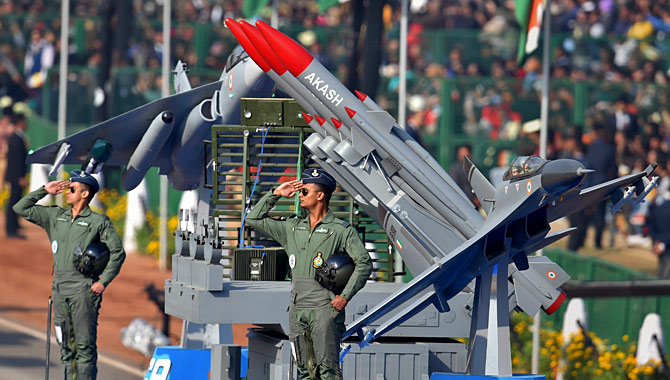
The Republic Day parade commenced with Prime Minister Narendra Damodardas Modi led the nation in paying homage to the fallen soldiers by laying a wreath at the Amar Jawan Jyoti at India Gate.
An eternal flame burns at the Amar Jawan Jyoti to commemorate the indomitable courage of armed forces personnel who have made the supreme sacrifice in the service of the country.
After unfurling the Tricolour, the National Anthem was played with a 21 gun salute following which President Kovind took the salute of marching contingents.

A major highlight of the parade was the participation of four Indian National Army veterans -- Parmanand, Lalti Ram, Hira Singh and Bhagmal, all aged over 90 years -- for the first time.
The other highlights include the display of American howitzers M777, the Main Battle Tank T-90 and indigenously developed Akash weapons system.
Nari Shakti (women power) was on full display at Rajpath with an all-woman Assam Rifles contingent creating history by participating for the first time in the parade, which was led by Maj Khushboo Kanwar.
Contingents of the navy, Army Service Corps and a unit of Corps of Signals (transportable satellite terminal) were also led by women officers.

The event took place under massive security cover as it took place days after two suspected Jaish-e-Mohammad terrorists were arrested.

The tableau from Maharashtra portrayed the Quit India movement while the tableau from Andaman and Nicobar showcased Mahatma Gandhi's role among the inmates of the cellular jail.
Jallianwala Bagh was the theme of the Punjab tableau. Assam had a tableau depicting Gandhi's movement in the state and his dream of rebuilding the rural economy. The Gujarat tableau depicted the Dandi March while Karnataka showcased Gandhi's momentous efforts at the Belgaum Congress session on December 26-27, 1924.
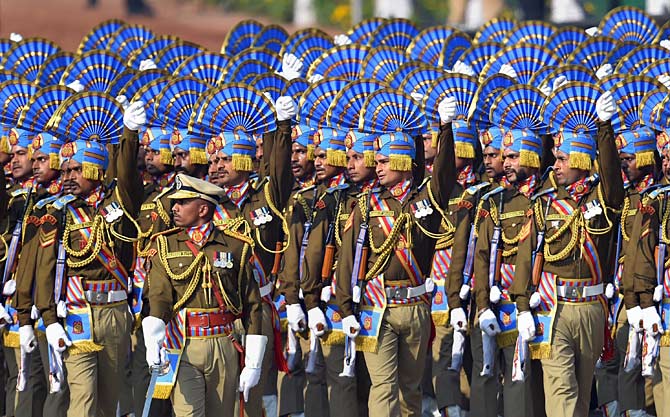
The marching contingents of the Indian Army included the Madras Regiment, the Rajputana Rifles, the Sikh Regiment and the Gorkha Brigade.
The naval contingent comprised of 144 young sailors led by Lieutenant Commander Ambika Sudhakaran. It was followed by the naval tableau titled 'Indian Navy -- Combat Ready Force for National Security'.

The Indian Air Force marching contingent also comprised 144 air warriors. It was followed by the IAF tableau titled 'Indian Air Force Encouraging Indigenisation' showcasing the scaled-down models of the aircraft, radar and missile system which have been indigenously designed and manufactured.
The models displayed were the Light Combat Aircraft, the Low-Level Light Weight Radar , the Sukhoi-30MKI and the Akash missile system.
Paramilitary and other auxiliary forces also participated in the parade along the National Cadet Corps and National Service Scheme.

The grand finale of the parade was a spectacular flypast by the Indian Air Force.
The flypast commenced with the Rudra formation comprising three advanced light helicopters in Vic formation, followed by the Hercules formation comprising three C-130J Super Hercules aircraft.
One C-17 Globemaster flanked by two Su-30 MKI fighter jets also displayed their aerial manoeuvring.

Next in line were 5 Jaguar deep penetration strike aircraft in Arrowhead formation. Following the Jaguars were 5 MiG-29 upgraded air superiority fighters also in Arrowhead formation.
The culmination of the parade was a lone Su-30 MKI flying at a speed of 900 km/hr with a Vertical Charlie manoeuvre over the saluting dais.







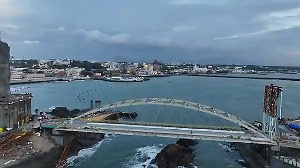
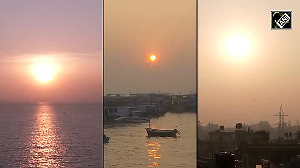

 © 2024 Rediff.com -
© 2024 Rediff.com -